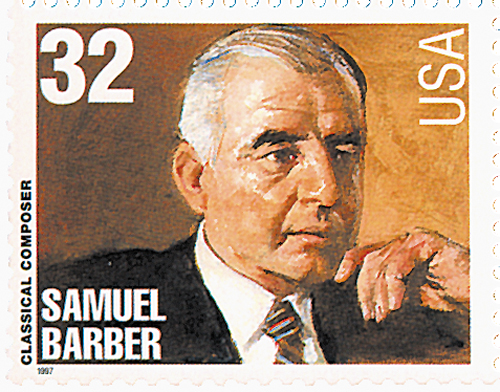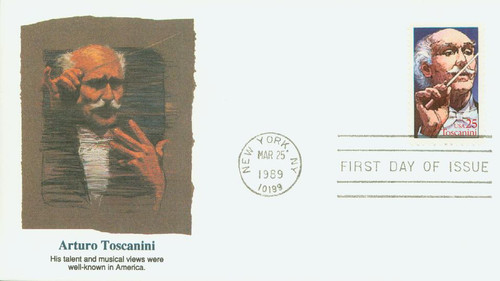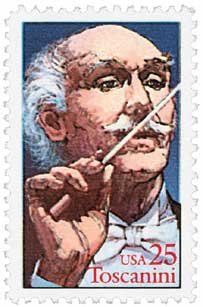
# 2411 FDC - 1989 25c Performing Arts: Arturo Toscanini
25¢ Arturo Toscanini
Performing Arts Series
City: New York, NY
Quantity: 152,250,000
Printed By: American Bank Note Co
Printing Method: Photogravure
Perforations: 11
Color: Multicolored
Birth Of Arturo Toscanini
Talented from a young age, Toscanini earned a scholarship to the local music conservatory where he studied cello. Then in 1886 he joined the orchestra of a touring opera company.
At just 19 years old, Toscanini made his conducting debut with this company while touring South America. At the time, the local conductor leading the orchestra was embroiled in a feud with the performers because he didn’t properly grasp the music. The singers threatened to strike, leading their manager to look for a new conductor. Two other men attempted the job but failed. Then the singers suggested Toscanini, who had been working as assistant chorus master. He had no conducting experience, but knew the whole opera by heart. So on June 25, 1886, Toscanini conducted the two-and-a-half hour Aida opera from memory.

Toscanini stunned the audience. They were surprised that he was so young and did such a masterful job in conducting the opera from memory. He gained instant fame and continued to conduct for the rest of the tour – another 18 operas.
When the tour was over Toscanini returned to Italy and continued to conduct and play cello. Among these performances were the premiere of the revised Edmea, which he conducted, and the premiere of Otello, in which he played cello. Over time, Toscanini’s skill as a conductor outshined his work as a cellist and it became his primary focus. He conducted additional world premieres, including Puccini’s La bohème and Leoncavallo’s Pagliacci. Toscanini conducted his first symphony in 1896, presenting the works of Schubert, Brahms, Tchaikovsky, and Wagner.

Beginning in 1898, Toscanini was made Principal Conductor at La Scala, a position he held for ten years. He would later return to La Scala as Music Director. Beginning in 1908, Toscanini began conducting in America at the Metropolitan Opera and the New York Philharmonic. He also toured Europe with the New York Philharmonic in 1930. During that tour Toscanini became the first non-German conductor to appear at the Bayreuth Theatre.

Back in Italy, Toscanini soon ran into trouble. Though Fascist leader Benito Mussolini called him “the greatest conductor in the world,” Toscanini didn’t agree with his politics. Then in 1931 Toscanini refused to play the Fascist anthem Giovinezza at a concert. He was attacked after the performance by a group of Fascist Blackshirts. Mussolini then placed him under surveillance, tapped his phone, and confiscated his passport. Once the public learned of this treatment, his passport was returned. Toscanini then left Italy until after World War II.

In 1937 Toscanini returned to America where the NBC Symphony Orchestra was created for him. He conducted his first NBC broadcast on December 25 of that year. The following year he conducted two world premiers of works by Samuel Barber – Adagio for Strings and Essay for Orchestra. Toscanini conducted several other American works including Ferde Grofé’s Grand Canyon Suite, George Gershwin’s An American in Paris and Rhapsody in Blue plus marches by John Philip Sousa.
Toscanini retired when he was 87 and spent his final years reviewing and editing his recordings. He died two years later, on January 16, 1957, in New York City. His epitaph includes a 1926 quote of his “Here the opera ends, because at this point the maestro has died.”
Click here for a short Toscanini video.
25¢ Arturo Toscanini
Performing Arts Series
City: New York, NY
Quantity: 152,250,000
Printed By: American Bank Note Co
Printing Method: Photogravure
Perforations: 11
Color: Multicolored
Birth Of Arturo Toscanini
Talented from a young age, Toscanini earned a scholarship to the local music conservatory where he studied cello. Then in 1886 he joined the orchestra of a touring opera company.
At just 19 years old, Toscanini made his conducting debut with this company while touring South America. At the time, the local conductor leading the orchestra was embroiled in a feud with the performers because he didn’t properly grasp the music. The singers threatened to strike, leading their manager to look for a new conductor. Two other men attempted the job but failed. Then the singers suggested Toscanini, who had been working as assistant chorus master. He had no conducting experience, but knew the whole opera by heart. So on June 25, 1886, Toscanini conducted the two-and-a-half hour Aida opera from memory.

Toscanini stunned the audience. They were surprised that he was so young and did such a masterful job in conducting the opera from memory. He gained instant fame and continued to conduct for the rest of the tour – another 18 operas.
When the tour was over Toscanini returned to Italy and continued to conduct and play cello. Among these performances were the premiere of the revised Edmea, which he conducted, and the premiere of Otello, in which he played cello. Over time, Toscanini’s skill as a conductor outshined his work as a cellist and it became his primary focus. He conducted additional world premieres, including Puccini’s La bohème and Leoncavallo’s Pagliacci. Toscanini conducted his first symphony in 1896, presenting the works of Schubert, Brahms, Tchaikovsky, and Wagner.

Beginning in 1898, Toscanini was made Principal Conductor at La Scala, a position he held for ten years. He would later return to La Scala as Music Director. Beginning in 1908, Toscanini began conducting in America at the Metropolitan Opera and the New York Philharmonic. He also toured Europe with the New York Philharmonic in 1930. During that tour Toscanini became the first non-German conductor to appear at the Bayreuth Theatre.

Back in Italy, Toscanini soon ran into trouble. Though Fascist leader Benito Mussolini called him “the greatest conductor in the world,” Toscanini didn’t agree with his politics. Then in 1931 Toscanini refused to play the Fascist anthem Giovinezza at a concert. He was attacked after the performance by a group of Fascist Blackshirts. Mussolini then placed him under surveillance, tapped his phone, and confiscated his passport. Once the public learned of this treatment, his passport was returned. Toscanini then left Italy until after World War II.

In 1937 Toscanini returned to America where the NBC Symphony Orchestra was created for him. He conducted his first NBC broadcast on December 25 of that year. The following year he conducted two world premiers of works by Samuel Barber – Adagio for Strings and Essay for Orchestra. Toscanini conducted several other American works including Ferde Grofé’s Grand Canyon Suite, George Gershwin’s An American in Paris and Rhapsody in Blue plus marches by John Philip Sousa.
Toscanini retired when he was 87 and spent his final years reviewing and editing his recordings. He died two years later, on January 16, 1957, in New York City. His epitaph includes a 1926 quote of his “Here the opera ends, because at this point the maestro has died.”
Click here for a short Toscanini video.









